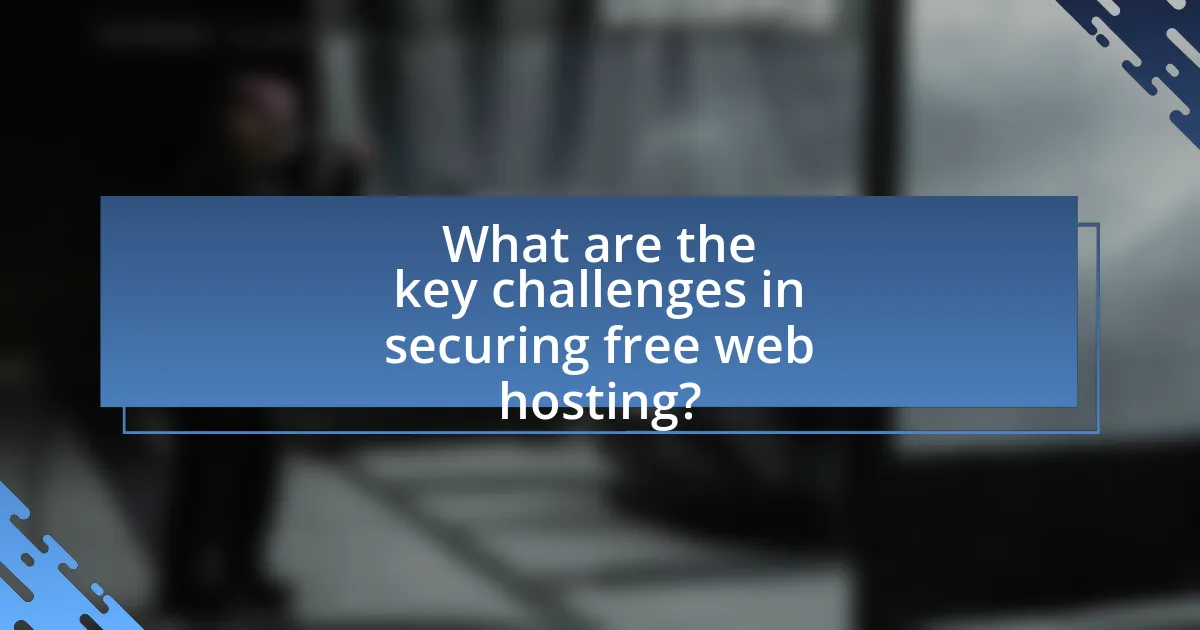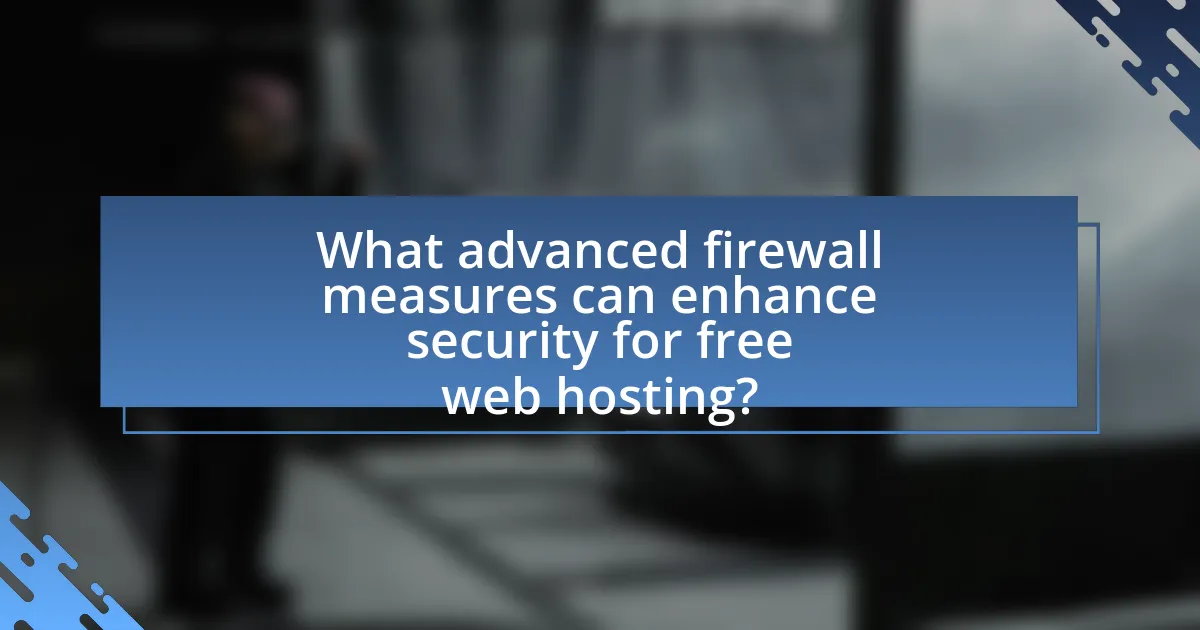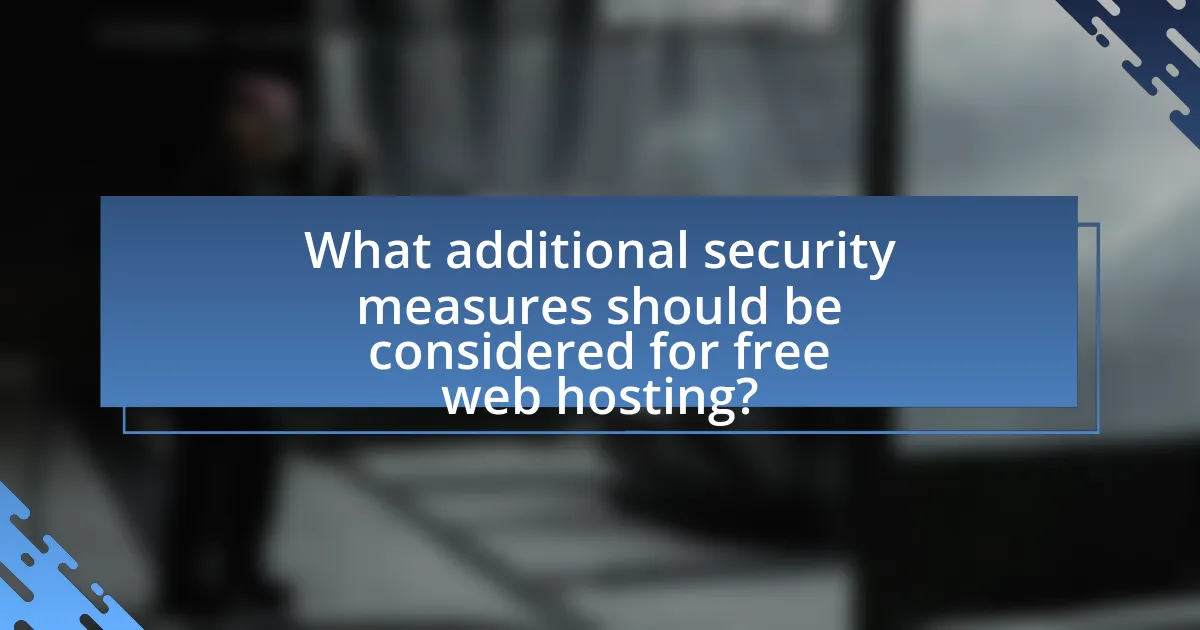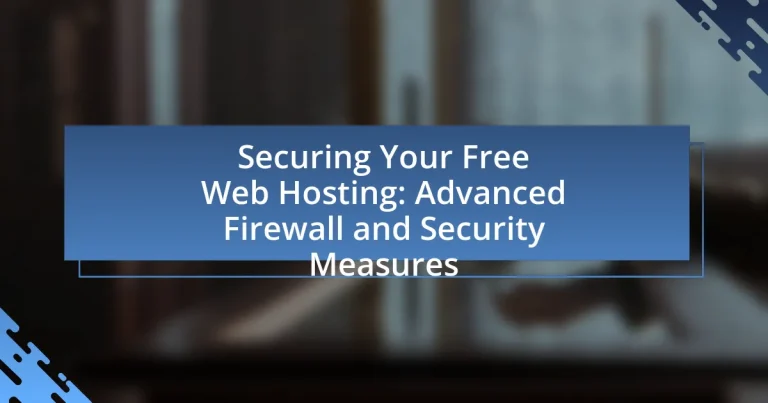The article focuses on the critical aspects of securing free web hosting services, highlighting the inherent challenges such as limited resources, lack of control, and potential vulnerabilities that expose websites to cyber threats. It discusses common vulnerabilities, including inadequate security measures and outdated software, which can lead to data breaches and performance issues. The article emphasizes the importance of implementing advanced firewall measures, intrusion detection systems, and SSL certificates to enhance security. Additionally, it outlines best practices for maintaining security, including regular updates and strong password policies, to mitigate risks associated with free web hosting environments.

What are the key challenges in securing free web hosting?
The key challenges in securing free web hosting include limited resources, lack of control, and potential vulnerabilities. Free web hosting services often provide minimal security features, which can leave websites exposed to attacks. Additionally, users typically have little control over server configurations, making it difficult to implement necessary security measures. A study by the Cybersecurity & Infrastructure Security Agency (CISA) highlights that free hosting platforms are frequently targeted due to their lower security standards, increasing the risk of data breaches and malware infections.
Why is security a concern for free web hosting users?
Security is a concern for free web hosting users because these services often lack robust security measures, making them vulnerable to cyberattacks. Free web hosting providers typically have limited resources to invest in security infrastructure, which can lead to inadequate protection against threats such as data breaches, malware, and hacking attempts. According to a study by the Cybersecurity & Infrastructure Security Agency, free hosting platforms are frequently targeted due to their lower security standards, resulting in higher risks for users who may not have the technical expertise to secure their websites effectively.
What types of vulnerabilities are common in free web hosting?
Common vulnerabilities in free web hosting include inadequate security measures, outdated software, and lack of support for security patches. These platforms often do not implement robust firewalls or intrusion detection systems, making them susceptible to attacks such as cross-site scripting (XSS), SQL injection, and malware infections. Additionally, shared hosting environments can lead to account isolation issues, where one compromised account can affect others on the same server. Research indicates that 60% of free hosting services do not provide regular updates, increasing the risk of exploitation by attackers.
How do these vulnerabilities impact website performance and data safety?
Vulnerabilities significantly degrade website performance and compromise data safety. When a website is vulnerable, it becomes susceptible to attacks such as Distributed Denial of Service (DDoS), which can overwhelm server resources, leading to slow loading times or complete outages. Additionally, vulnerabilities can allow unauthorized access to sensitive data, resulting in data breaches that expose personal information. For instance, according to a report by IBM, the average cost of a data breach in 2021 was $4.24 million, highlighting the financial impact of compromised data safety. Furthermore, websites with known vulnerabilities often face reduced trust from users, which can lead to decreased traffic and revenue.
What are the potential risks associated with free web hosting?
Free web hosting poses several potential risks, including limited security, lack of customer support, and data loss. The absence of robust security measures can make websites vulnerable to hacking and malware attacks, as many free hosting services do not implement advanced firewalls or regular security updates. Additionally, free hosting often comes with minimal customer support, which can hinder timely resolution of issues. Furthermore, data loss is a significant concern, as free hosting providers may not offer reliable backup solutions, increasing the risk of losing important website content.
How can malicious attacks exploit free web hosting services?
Malicious attacks can exploit free web hosting services by taking advantage of their inherent security vulnerabilities and lack of robust protections. These services often have weak security measures, making them attractive targets for attackers who can deploy malware, phishing schemes, or DDoS attacks. For instance, a study by the Cybersecurity & Infrastructure Security Agency (CISA) highlights that free hosting platforms frequently lack proper encryption and monitoring, which can lead to data breaches and unauthorized access. Additionally, attackers may use these platforms to host malicious content, leveraging the anonymity and low cost associated with free services to evade detection.
What are the consequences of data breaches in free web hosting?
Data breaches in free web hosting can lead to severe consequences, including unauthorized access to sensitive information, loss of user trust, and potential legal liabilities. When a data breach occurs, attackers can exploit vulnerabilities to access personal data, such as email addresses, passwords, and financial information, which can be used for identity theft or fraud. According to a 2020 report by IBM, the average cost of a data breach is $3.86 million, highlighting the financial impact on organizations. Additionally, free web hosting services often lack robust security measures, making them more susceptible to attacks, which can further exacerbate the consequences. The loss of user trust can result in decreased website traffic and revenue, as users may choose to avoid platforms that have experienced breaches.

What advanced firewall measures can enhance security for free web hosting?
Advanced firewall measures that can enhance security for free web hosting include implementing Web Application Firewalls (WAFs), Intrusion Detection Systems (IDS), and regular updates to firewall rules. WAFs protect web applications by filtering and monitoring HTTP traffic between a web application and the internet, effectively blocking attacks such as SQL injection and cross-site scripting. IDS monitors network traffic for suspicious activity and alerts administrators, allowing for timely responses to potential threats. Regularly updating firewall rules ensures that the firewall can defend against the latest vulnerabilities and attack vectors, which is crucial for maintaining security in a free hosting environment that may lack robust built-in protections.
How do firewalls protect free web hosting environments?
Firewalls protect free web hosting environments by monitoring and controlling incoming and outgoing network traffic based on predetermined security rules. They act as a barrier between trusted internal networks and untrusted external networks, preventing unauthorized access and potential attacks. For instance, firewalls can block malicious traffic, such as Distributed Denial of Service (DDoS) attacks, which can overwhelm a server and disrupt services. Additionally, they can filter out harmful content and prevent data breaches by restricting access to sensitive information. This functionality is crucial in free web hosting environments, where resources are often limited and security vulnerabilities are more prevalent.
What types of firewalls are most effective for free web hosting?
The most effective types of firewalls for free web hosting are application-layer firewalls and network firewalls. Application-layer firewalls, such as Web Application Firewalls (WAFs), specifically protect web applications by filtering and monitoring HTTP traffic between a web application and the Internet, effectively blocking attacks like SQL injection and cross-site scripting. Network firewalls, on the other hand, provide a broader level of protection by controlling incoming and outgoing network traffic based on predetermined security rules, which is essential for safeguarding the server infrastructure. These firewalls are crucial for free web hosting environments, where resources are limited and security vulnerabilities can be exploited more easily.
How can users configure firewalls to maximize protection?
Users can configure firewalls to maximize protection by implementing strict access control rules, enabling logging and monitoring, and regularly updating firewall software. Strict access control rules limit incoming and outgoing traffic to only necessary services, reducing potential attack vectors. Enabling logging and monitoring allows users to track suspicious activities and respond promptly to threats. Regularly updating firewall software ensures that users benefit from the latest security patches and features, which is crucial as vulnerabilities are continuously discovered. These practices collectively enhance the firewall’s effectiveness in safeguarding web hosting environments.
What role does intrusion detection play in securing free web hosting?
Intrusion detection plays a critical role in securing free web hosting by monitoring network traffic for suspicious activities and potential threats. This proactive approach enables the identification of unauthorized access attempts, malware infections, and other security breaches in real-time. By implementing intrusion detection systems (IDS), web hosting providers can analyze patterns and behaviors that deviate from normal operations, allowing for swift responses to mitigate risks. According to a study by the National Institute of Standards and Technology, effective intrusion detection can reduce the impact of security incidents by up to 50%, highlighting its importance in maintaining the integrity and safety of free web hosting environments.
How can intrusion detection systems identify potential threats?
Intrusion detection systems identify potential threats by monitoring network traffic and system activities for suspicious patterns or anomalies. These systems utilize various techniques, such as signature-based detection, which compares incoming data against known threat signatures, and anomaly-based detection, which establishes a baseline of normal behavior to identify deviations. For instance, according to a study by the National Institute of Standards and Technology, signature-based methods can detect 90% of known threats, while anomaly-based methods can uncover previously unknown threats by flagging unusual behavior. This dual approach enhances the overall security posture by enabling timely detection and response to potential intrusions.
What are the best practices for implementing intrusion detection?
The best practices for implementing intrusion detection include deploying a combination of network-based and host-based intrusion detection systems (NIDS and HIDS), regularly updating detection signatures, and configuring alerts for suspicious activities. Utilizing both NIDS and HIDS allows for comprehensive monitoring of network traffic and system logs, enhancing the ability to detect potential threats. Regular updates to detection signatures ensure that the system can identify the latest threats, as evidenced by the rapid evolution of malware and attack techniques. Additionally, configuring alerts for unusual patterns or behaviors enables timely responses to potential intrusions, which is critical for minimizing damage and maintaining security.

What additional security measures should be considered for free web hosting?
For free web hosting, additional security measures should include implementing SSL certificates, regular backups, and using a web application firewall (WAF). SSL certificates encrypt data transmitted between the user and the server, protecting sensitive information from interception. Regular backups ensure that data can be restored in case of a breach or data loss, which is crucial for maintaining website integrity. A web application firewall helps filter and monitor HTTP traffic to and from the web application, blocking malicious requests and preventing attacks such as SQL injection and cross-site scripting. These measures collectively enhance the security posture of free web hosting environments, which are often more vulnerable to threats due to limited resources and support.
How can users implement SSL certificates for enhanced security?
Users can implement SSL certificates for enhanced security by obtaining a certificate from a trusted Certificate Authority (CA) and configuring it on their web server. This process typically involves generating a Certificate Signing Request (CSR), submitting it to the CA, and then installing the issued certificate on the server. According to the Internet Security Research Group, which provides free SSL certificates through Let’s Encrypt, using SSL/TLS can significantly reduce the risk of data interception and improve user trust, as websites with SSL certificates display a padlock icon in the browser, indicating a secure connection.
What are the benefits of using SSL on free web hosting platforms?
Using SSL on free web hosting platforms enhances security by encrypting data transmitted between the user’s browser and the server. This encryption protects sensitive information, such as login credentials and personal data, from interception by malicious actors. Additionally, SSL improves trustworthiness, as browsers display security indicators, such as a padlock icon, which can increase user confidence in the website. Furthermore, search engines like Google prioritize SSL-enabled sites in their rankings, potentially improving visibility and traffic. According to a 2020 study by the Internet Security Research Group, websites with SSL certificates experience a 30% increase in user engagement, highlighting the tangible benefits of SSL implementation.
How can users obtain and install SSL certificates on their sites?
Users can obtain and install SSL certificates on their sites by following a structured process. First, they need to choose a Certificate Authority (CA) to purchase or obtain a free SSL certificate, such as Let’s Encrypt. After selecting a CA, users must generate a Certificate Signing Request (CSR) from their web hosting control panel or server. This CSR is then submitted to the CA, which verifies the user’s identity and issues the SSL certificate.
Once the SSL certificate is received, users must install it on their web server. This typically involves uploading the certificate files to the server and configuring the web server software (like Apache or Nginx) to use the SSL certificate. Finally, users should test the installation using online tools to ensure that the SSL certificate is correctly configured and that their site is accessible via HTTPS.
What are the best practices for maintaining security on free web hosting?
To maintain security on free web hosting, users should implement strong password policies, regularly update software, and utilize SSL certificates. Strong passwords reduce the risk of unauthorized access, while regular software updates patch vulnerabilities that could be exploited by attackers. SSL certificates encrypt data transmitted between the user and the server, enhancing data security. According to a study by the Ponemon Institute, 60% of small businesses that experience a cyber attack go out of business within six months, highlighting the importance of these security measures.
How often should users update their security measures?
Users should update their security measures at least every three to six months. Regular updates are essential due to the evolving nature of cyber threats, as vulnerabilities can emerge rapidly. According to the Cybersecurity & Infrastructure Security Agency (CISA), timely updates help mitigate risks associated with newly discovered exploits and malware. Additionally, organizations like the National Institute of Standards and Technology (NIST) recommend routine assessments and updates to security protocols to ensure ongoing protection against potential breaches.
What common mistakes should users avoid when securing their sites?
Users should avoid using weak passwords when securing their sites, as weak passwords are easily compromised. According to a study by Verizon, 81% of data breaches are linked to weak or stolen passwords. Additionally, users should not neglect regular software updates, as outdated software can contain vulnerabilities that hackers exploit. The National Cyber Security Centre emphasizes that timely updates are crucial for maintaining security. Furthermore, users should avoid ignoring security settings and configurations, as misconfigured settings can leave sites exposed. A report from the Ponemon Institute indicates that 60% of data breaches are due to misconfigured security settings. Lastly, users should refrain from relying solely on free security tools, as they may not provide comprehensive protection; investing in reputable security solutions is essential for robust site security.
What practical tips can help users secure their free web hosting effectively?
To secure free web hosting effectively, users should implement strong passwords, regularly update software, and utilize SSL certificates. Strong passwords reduce the risk of unauthorized access, as studies show that 81% of data breaches are due to weak passwords. Regular software updates patch vulnerabilities, with 60% of breaches exploiting known flaws. SSL certificates encrypt data during transmission, enhancing security and boosting user trust. Additionally, users should enable two-factor authentication (2FA) where available, as it adds an extra layer of protection against unauthorized access.


